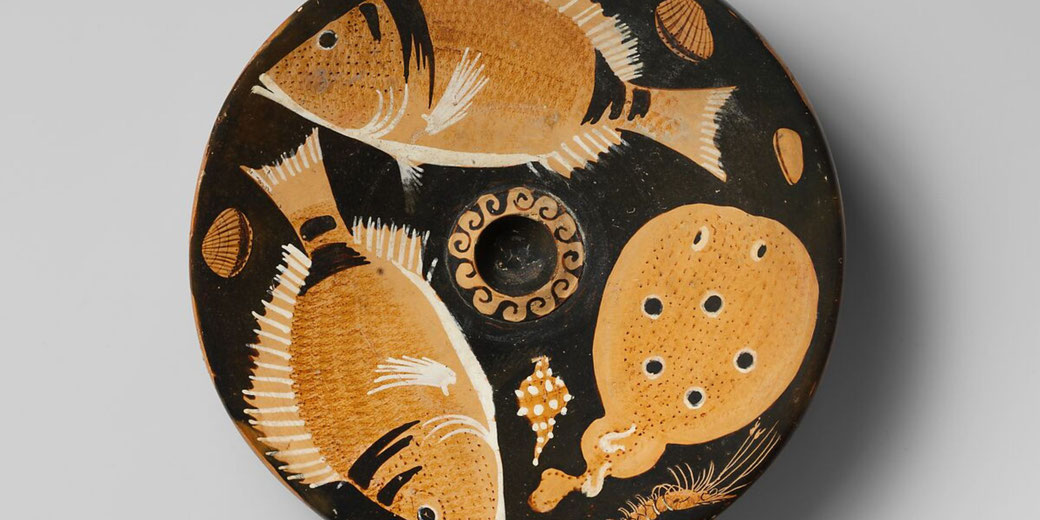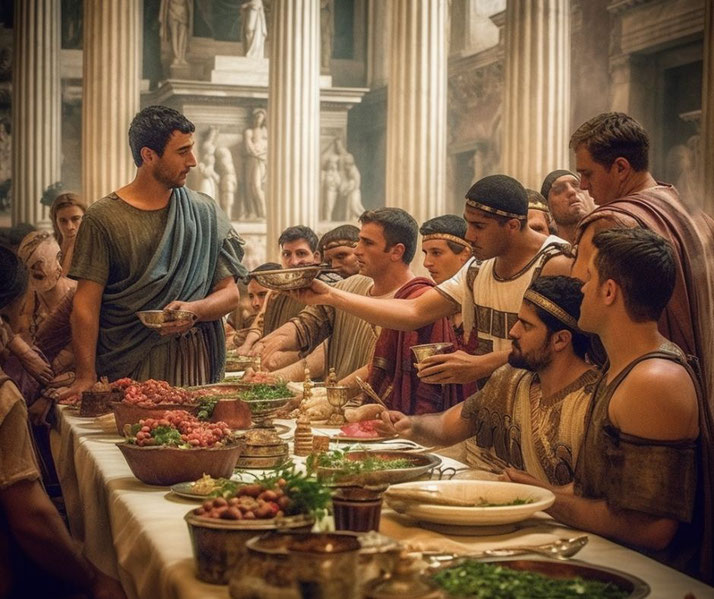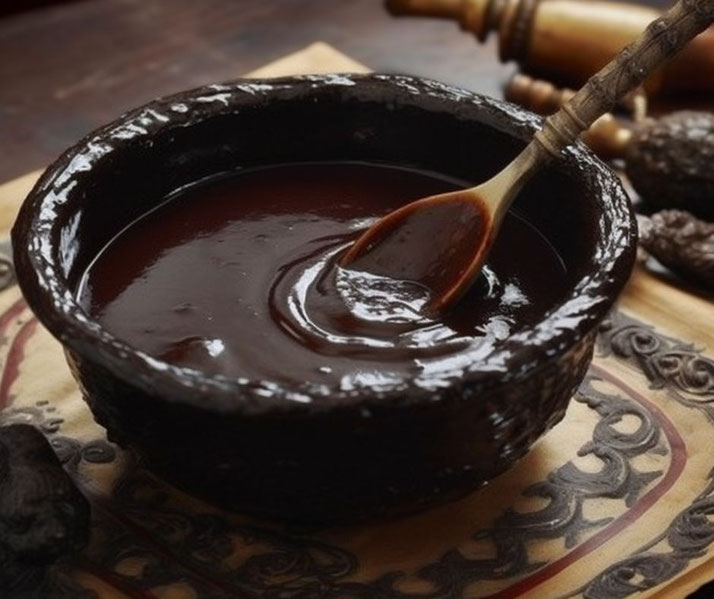Garum: Ancient Rome's favourite, and utterly repulsive, condiment

In the opulent courts of the Roman Empire, where the cuisine was as varied and vast as the empire itself, a unique condiment reigned supreme: garum.
This fermented fish sauce, an intriguing blend of the humble and the exotic, held an unparalleled culinary and cultural status in Roman society.
It was more than just a flavor enhancer - garum represented the gastronomic identity of an era, a symbol of prosperity, a catalyst of trade, and a subject of fascination for archaeologists and historians alike.
But what exactly was garum, and how was it made?
Why did it hold such a significant place in Roman society?
And perhaps most intriguingly, does the legacy of garum still endure in our modern cuisine?
The disgusting origins of garum
The rich story of garum finds its roots in the fertile crescent of gastronomy that encompassed the Mediterranean basin in the ancient world.
As with many culinary innovations, the birthplace of this distinctive fish sauce is difficult to pinpoint with certainty.
Still, it is widely believed that the Greeks, Phoenicians, and Carthaginians, known for their seafaring and fishing cultures, were the likely progenitors of this sauce.
In early iterations, fish was likely fermented as a means of preservation, a common practice among ancient societies.
Over time, this method evolved into a culinary practice, with the resultant product becoming a key ingredient in diverse cuisines.
The Greeks had a variant called "garos," perhaps the precursor to the Roman garum.
It is crucial to note that while these early versions were similar, each culture likely had its unique recipe and production method, tailored to local tastes and fish species.
When the burgeoning Roman Empire began to assimilate these cultures, it also absorbed their culinary traditions.
Thus, garum likely found its way to Roman cuisine. However, the Romans did more than just adopt garum; they elevated it to an art form.
As Rome flourished, so too did garum, evolving from a humble fermented fish paste into an intricate condiment that graced every Roman table.

Garum's introduction into Roman life was timely, as it was during a period of expansion and prosperity in the Empire.
As Rome's influence spread across the Mediterranean, so too did its taste for this piquant sauce.
In time, garum became a cornerstone of Roman gastronomy, beloved by both the patricians in their grand villas and the plebeians in their modest abodes.
A meal, no matter how grand or humble, seemed incomplete without the signature taste of garum.
How was garum made?
Garum's unique allure was rooted in its simplicity of ingredients yet complexity in flavor.
The preparation of garum was an intricate process that required skill, time, and an intimate understanding of fermentation.
At its core, the main ingredients were fish or fish innards, salt, and time. The fish used could range from mackerel, sardines, or anchovies to the leftover parts from other seafood.
This variety of raw materials allowed for different grades of garum, with versions made from whole, high-quality fish being the most expensive.
To begin the process, the fish or fish parts were layered with salt in a large container or vat.
The ratio of salt to fish varied based on the recipe, but it was generally substantial enough to ensure preservation. Some recipes added herbs, spices, and even wine, but the essence of garum was in the fermentation of fish and salt.
Once prepared, the mixture was left to ferment under the sun for several weeks or even months.
This process of enzymatic breakdown released a flavorful liquid, often collected from a tap at the bottom of the vat.
This liquid, laden with the essence of the fish and the complex flavors developed during fermentation, was the garum sought after by Roman gourmets.
The remaining solid mass, known as 'allec,' was not wasted but was used in lesser culinary applications or as animal feed.
However, the preparation of garum was not a singular, rigid method. It varied from region to region and even from producer to producer.
The type of fish, the fermentation period, and the additional ingredients all played a part in creating different flavors of garum.
The Neapolitan garum, made from a particular variety of local fish, was among the most prized in the empire.

Why was garum so important to the ancient Romans?
The cultural importance of garum within the fabric of Roman society cannot be overstated.
It was more than a mere condiment; garum was a way of life, a symbol of prosperity, a social differentiator, and a staple that tied together the gastronomic landscape of the Empire.
In daily Roman life, garum was omnipresent. It added depth to humble vegetable dishes, enhanced the flavor of sumptuous stews, and was served as a dipping sauce during grand banquets.
Its ubiquitous use cut across social strata, from the lowly plebeian household where it stretched modest provisions, to patrician mansions where the finest variants, like garum of mackerel, were a mark of opulence.
Indeed, the type of garum one consumed became a reflection of their social status.
Garum also held a place of honor during festivities and special occasions. Festivals, public feasts, religious ceremonies, and private celebrations often showcased dishes with garum.
Its presence was considered auspicious and was a sign of hospitality and generosity.
Beyond the culinary sphere, garum had symbolic and medicinal uses. Ancient Roman medical treatises suggest that garum was used as a therapeutic remedy for a variety of ailments, from digestive issues to wound treatment.
This application further underlines the cultural significance of garum, as it transcended the realm of cuisine and entered that of medicine, a testament to its perceived virtues.
Furthermore, the cultural value of garum was enshrined in literature. Roman authors, including Pliny the Elder and Apicius, wrote about garum, extolling its virtues, discussing its varieties, and providing recipes that showcased its use.
This literary acknowledgement signifies the standing of garum in Roman society.

This repulsive sauce made the empire a lot of money...
Garum's influence extended beyond the culinary and cultural realm into the economic sphere of the Roman Empire.
It became a key industry that fueled commerce, spurred trade, and provided livelihoods for many Romans.
Garum production was a profitable enterprise that permeated the Roman Empire. Factories known as 'garum factories' or 'garum workshops' sprung up across the Mediterranean, notably in Spain, Portugal, North Africa, and southern Italy.
These factories were often located near the coast due to the availability of fresh fish, a key ingredient.
The proximity to the sea also facilitated the transportation of garum to various parts of the Empire.
Trade and distribution of garum was a massive operation. The sauce was packed into amphorae – large, pointed-bottom jars – labeled with information about the product, the producer, and the place of production.
These amphorae were then shipped across the Mediterranean Sea, reaching every corner of the Empire.
The volume of garum transported was so considerable that it stimulated the development of complex trade networks and routes, contributing to the interconnectedness of the Roman Empire.
The workers involved in the production of garum ranged from fishermen, who provided the primary ingredient, to the laborers at the factories who handled the fermentation process and packing.
It is worth noting that, given the strong smell associated with the fermentation process, these factories were often situated outside the main city areas, and the work was arduous.
However, the economic returns made the garum industry an attractive one.
Moreover, the price of garum varied significantly, largely based on the quality of fish used and the place of production.
Some rare variants were worth their weight in gold, while the more common versions were affordable for the general populace.
This price diversity ensured the widespread use of garum across all societal levels, fueling constant demand for the product.

The surprising archaeological evidence of garum
Archaeology has played a crucial role in unearthing the history of garum, shedding light on its production, distribution, and use in Roman society.
Numerous findings across the expanse of the former Roman Empire provide tangible evidence of the prevalence and importance of this fish sauce.
A wealth of archaeological evidence comes from the remains of garum workshops, or "officinas."
These production sites, discovered in places like Pompeii in Italy, Baelo Claudia in Spain, and Sabratha in Libya, provide insight into the scale and organization of garum production.
They include installations for fish processing, fermentation vats, and areas for packing the sauce into amphorae.
One of the most significant pieces of evidence is the amphorae themselves. Thousands of these large ceramic jars, often bearing maker's marks and labels, have been discovered in shipwrecks, at production sites, and in urban and rural Roman settlements.
These labels sometimes specify the type of fish used, the producer, and the place of production, offering valuable information about the garum trade.
Archaeologists have also discovered garum in the kitchens and dining rooms of ancient Roman homes.
In Pompeii, for example, garum amphorae were found in the House of the Chaste Lovers, illustrating the condiment's ubiquity in Roman cuisine.
In some instances, traces of garum have been detected in the food residues inside cooking pots.
Ancient Roman literary sources, while not archaeological, provide another layer of evidence about garum.
Writers such as Pliny the Elder, Strabo, and Horace make mention of garum in their works, indicating its popularity and widespread use.

Why did Romans stop eating garum?
The decline and disappearance of garum, much like the decline of the Roman Empire itself, were not sudden but gradual processes influenced by a variety of factors, from societal changes to economic shifts.
The fall of the Western Roman Empire in the 5th century AD marked the beginning of significant societal and cultural transformations.
As the Empire splintered and fell into decline, the extensive trade networks that facilitated the widespread distribution of garum were disrupted.
Garum factories, once the backbone of bustling coastal economies, started to wane, adversely affected by the instability of the times.
Another factor in the decline of garum was the rising influence of Christianity in Europe.
The Christian church, taking a cue from Jewish dietary laws, often regarded the consumption of fish-based sauces as a form of luxury and excess, incompatible with the religion's ideals of modesty and austerity.
Over time, this resulted in a gradual shift away from garum in the diets of the Christianized populace.
The change in culinary tastes and food preservation methods also played a role in the disappearance of garum.
With the advent of new ingredients from the East, such as exotic spices, and advancements in preservation techniques, the once indispensable fish sauce started losing its appeal and importance in European cuisine.
However, it is essential to note that while garum disappeared in name, it never entirely vanished in spirit.
The tradition of fermented fish sauces carried on in different forms around the Mediterranean and beyond.
You can still eat garum today ... sort of
Even though garum itself has disappeared from our dining tables, its legacy continues in various fermented fish sauces used in cuisines worldwide today.
The similarities between ancient garum and these contemporary sauces provide a fascinating insight into the continuity of gastronomic traditions.
One of the most direct descendants of garum is the aforementioned Italian 'colatura di alici.'
Produced in the town of Cetara on the Amalfi Coast, this amber-hued sauce is made by fermenting anchovies with salt in wooden barrels.
Its strong, umami-rich flavor closely resembles the descriptions of garum in ancient texts.
However, it's not just in Italy where we find the spirit of garum alive. A world away in Southeast Asia, the tradition of fermenting fish to produce robust, flavorful sauces is an integral part of local cuisines.
The Vietnamese 'nước mắm,' Thai 'nam pla,' and Philippine 'patis' are all fish sauces that bear striking similarities to garum in terms of preparation and flavor profile.
They are produced by fermenting fish with salt, much like the Romans did, and are used extensively as a flavor enhancer in cooking.
Even Worcestershire sauce, a familiar face in Western kitchens, owes a nod to garum.
This British condiment contains anchovies among its ingredients, and its umami-rich, deeply savory flavor is reminiscent of what ancient texts ascribe to garum.
Despite these similarities, it's essential to note that each of these sauces has evolved within its unique cultural and historical context.
They are more than just modern-day garum; they represent the rich tapestry of their respective regional cuisines.
While they share a common thread in their reliance on the fermentative transformation of fish, each carries a unique blend of flavors, mirroring the local palate and culinary traditions.
The continued existence of these garum-like sauces in contemporary cuisine is a testament to our ancestors' culinary wisdom.
Even as we innovate and experiment in the kitchen, these ancient practices remain relevant, reminding us of the enduring power of food as a cultural connector that transcends time and geographical boundaries.
What do you need help with?
Download ready-to-use digital learning resources
Copyright © History Skills 2014-2025.
Contact via email
With the exception of links to external sites, some historical sources and extracts from specific publications, all content on this website is copyrighted by History Skills. This content may not be copied, republished or redistributed without written permission from the website creator. Please use the Contact page to obtain relevant permission.





